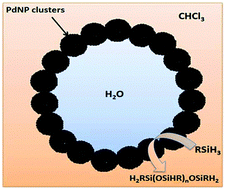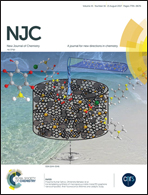Palladium nanoparticles anchored on polymer vesicles as Pickering interfacial catalysts for hydrolytic oxidation of organosilanes†
Abstract
The self assembly of amphiphilic palladium nanoparticles (PdNPs) stabilized with a block copolymer, PiBMA45-b-PDMS75-b-PiBMA45 (PiBMA = polyisobornyl methacrylate, PDMS = polydimethylsiloxane), readily attains vesicular morphology and acts as an emulsifying agent to stabilize the dispersion of small water droplets in chloroform. The performance of the thus formed Pickering catalyst was examined for a cross dehydrocoupling reaction between primary organosilanes, RSiH3 and water. Entrapment of the functional vesicles at the water–chloroform interface enhances the contact region between two immiscible reagents and offers a viable approach for the synthesis of linear poly(hydrosiloxane)s, H2RSi[OSiRH]nOSiRH2 [R = Ph (4), n-Hex (5), n-Oct (6), ThMe2SiCH2CH2 (7), and Ph2MeSiCH2CH2 (8)]. The HR-TEM micrographs reveal that the catalyst does not undergo structural reorganization before and after the catalytic event suggesting its high stability and recyclability.



 Please wait while we load your content...
Please wait while we load your content...